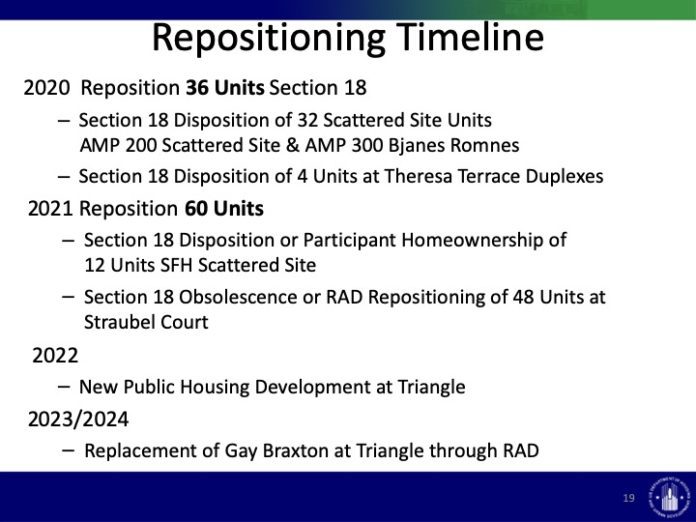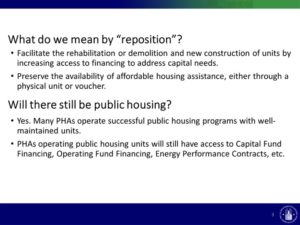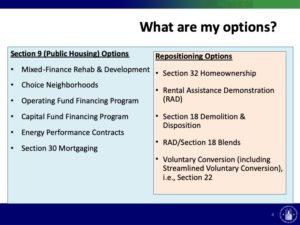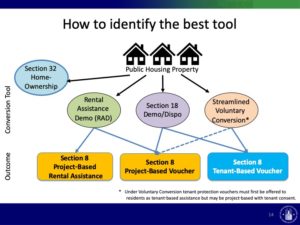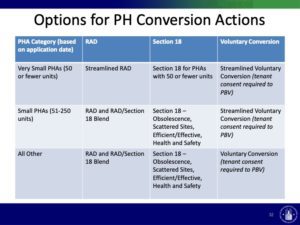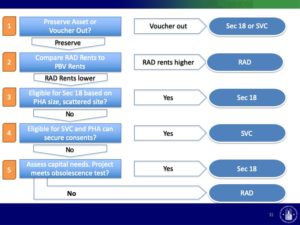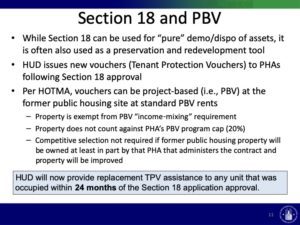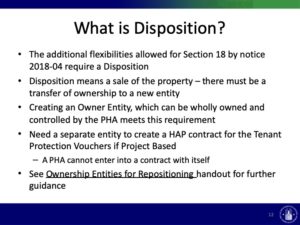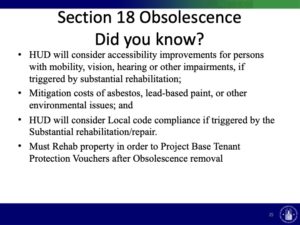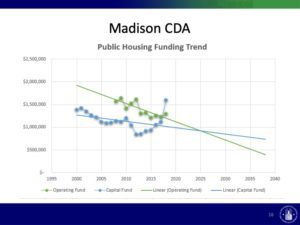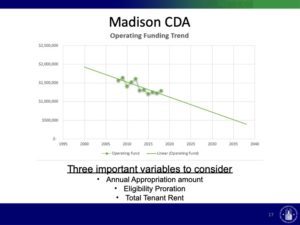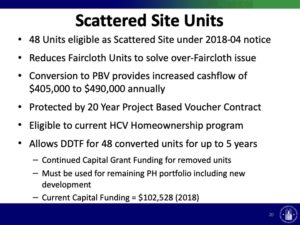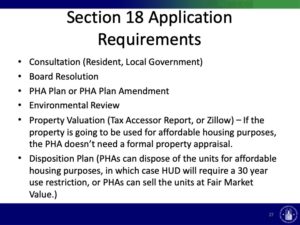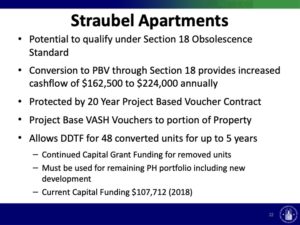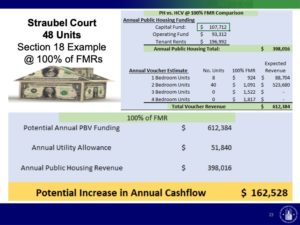CDA has big plans for scattered site public housing, Straubel Court and the Triangle. They are starting with the Scattered Site housing with a resolution on their agenda today.
The lingo here is rough. I’ll try to unpack that for you, but I lost the audio from the presentation and I’m doing it from memory/with limited informatioh. Here’s the agenda for today, which also has the armed security guards for public housing on it as well.
RESOLUTION UP FOR ADOPTION
WHEREAS, the Community Development Authority (CDA) faces many issues with its public housing portfolio including currently operating 8 units of public housing over what is allowed by the Faircloth limit and an estimated $10 million in unmet capital needs; and
WHEREAS, the Department of Housing and Urban Development (HUD) issued guidance under the Section 18 program to provide greater efficiencies for Public Housing Agencies (PHAs) to address the growing backlog of unmet capital needs; and
WHEREAS, Section 18 of the U.S. Housing Act of 1937 authorizes PHAs to demolish and/or dispose of certain public housing units, including scattered site units, after receiving approval from the HUD Special Applications Center (SAC); and
WHEREAS, the CDA currently owns and manages 32 scattered site units which are defined as units in non-contiguous buildings with four or fewer total units which are eligible for disposition under the Section 18 program; and
WHEREAS, after consultation with HUD staff, CDA staff recommend the CDA submits a Section 18 scattered site disposition application to the HUD Special Applications Center for 32 scattered site units,
NOW, THEREFORE, BE IT RESOLVED that CDA staff are authorized to begin an application to the HUD Special Applications Center for the disposition of 32 units of scattered site Public Housing.
BACKGROUND INFORMATION ON REPOSITIONING
Here’s the full powerpoint presentation in a bit different order than presented here.
Here’s the full Tenant Talk Edition from the National Low Income Housing Coalition
HUD info for CDA
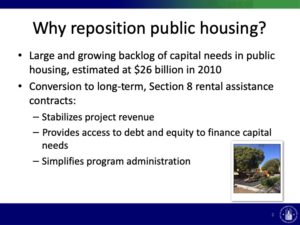 National Low Income Housing Coalition Information
National Low Income Housing Coalition Information
Public Housing ‘Repositioning’
HUD’s Office of Public and Indian Housing (PIH) sent a letter to public housing agency (PHA) executive directors dated November 13, 2018 signaling its intent to remove itself from administering the public housing program. HUD’s immediate goal was to “reposition” 105,000 public housing units by September 30, 2019.
Because Congress has failed to provide adequate appropriations for the Public Housing Capital Fund for many years, there is an approximate $70 billion backlog in capital needs (public housing maintenance and repairs). HUD points to that backlog as the reason to provide PHAs with “additional flexibilities” so they can “reposition” public housing.
What is “repositioning?” There are three main ways HUD would “reposition” public housing:
- The Rental Assistance Demonstration (RAD)
- Demolishing or disposing of (selling) public housing
- Voluntary conversion of public housing to vouchers
All of these have already been available to PHAs. Repositioning just means making them easier.
Why Might Converting Some Public Housing to Section 8 Be Okay?
Converting some public housing to Section 8 might be necessary because Congress continues to underfund public housing, leading to deteriorating buildings and the loss of units through demolition. Congress is more likely to provide adequate funding for existing Section 8 contracts than for public housing. And, if a long-term rental assistance contract is tied to a property, private institutions might be more willing to lend money for critical building repairs. Therefore, some homes that were public housing before conversion are more likely to remain available and affordable to people with extremely low- and very low-incomes because of long-term Section 8 contracts.
OPTIONS IN REPOSITIONING PUBLIC HOUSING
For these first units, CDA is choosing the Section 18 Demolition and Disposition option. And they are disposing of the units, I believe, by selling them to another entity that they are “creating” in agenda item 7 – the Madison Revitalization and Community Development Corporation Board of Directors. They are “nominating” 6 of the 7 members of the CDA to sit on the board of this new corporation. I don’t have details about how this entity is being formed, there is very little information in agenda item 7.
SECTION 18 DEMOLITION OR DISPOSITION
HUD info for CDA
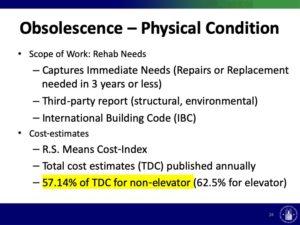 One of the slides says to go here for more information:
One of the slides says to go here for more information:
- Demolition & Disposition (Section 18):
https://www.hud.gov/program_offices/public_indian_housing/centers/sac/demo_dispo
National Low Income Housing Coalition Information
Since 1983, HUD has authorized PHAs to apply for permission to demolish or dispose of (sell) public housing units under Section 18 of the Housing Act of 1937. In 1995 Congress ended the requirement that PHAs replace on a one-for-one basis public housing lost through demolition or disposition. In 2016, HUD reported a net loss of more than 139,000 public housing units due to demolition or disposition since 2000.
A PHA must apply to HUD’s Special Applications Center (SAC) to demolish or sell public housing. The application must certify the PHA has described the demo or dispo in its Annual PHA Plan and the description in the application must be identical. Advocates should challenge an application that is significantly different. The information in this article is primarily from the regulations 24 CFR 970.
In 2018, the Trump administration eliminated a 2012 HUD Notice that had modest improvements advocates had suggested. The 2012 Notice served as a reminder to residents, the public, and PHAs of PHAs’ obligations regarding resident involvement and the role of the PHA Plan regarding demo/dispo. The replacement, Notice PIH 2018-04, downplays the role of resident consultation to make demo/dispo easier.
In addition, the Trump administration withdrew proposed regulation changes drafted in 2014 that would have reinforced the modest improvements in the 2012 Notice and required PHAs to submit more detailed justifications for demo/dispo. All of this is a part of the administration’s goal of “repositioning” 105,000 public housing units by September 30, 2019.
Resident Participation
A PHA must prepare a demo/dispo application “in consultation” with tenants and any tenant organization at a project, as well as with any PHA-wide tenant organization and the Resident Advisory Board (RAB). The application (form HUD-52860) must include any written comments made by residents, resident organizations, or the RAB, and indicate in writing how the PHA responded to comments. HUD can deny an application if tenants, resident councils, or RABs were not consulted, so residents should challenge an application if they were not consulted or if the consultation was grossly inadequate.
Demolition Applications
Is the Public Housing Obsolete? PHAs must certify that a development is “obsolete,” either physically or in terms of location, and therefore no longer suitable as housing.
Physically obsolete means there are structural deficiencies that cannot be corrected at a reasonable cost. Structural deficiencies can include settlement of floors, severe erosion, and deficiencies in major systems like plumbing, electrical, heating and cooling, roofs, doors, and windows. “Reasonable” cost is defined as less than 62.5% of total development costs for buildings with elevators and 57.14% for other buildings. To show a development is physically obsolete, a PHA must submit a detailed scope of work describing the major systems needing repair or replacement, the need to remove lead-based paint and asbestos hazards, or the need to make accessibility improvements for people with physical impairments.
An obsolete location means the surrounding neighborhood is too deteriorated or has shifted from residential uses to commercial or industrial uses. It can also mean environmental conditions make it unsuitable for residents to live there. “Other factors” that “seriously affect the marketability or usefulness” of the development can also be considered.
“De Minimus” Demolition. PHAs do not have to apply to HUD to demolish fewer than 5 units or 5% of all units over a five-year period. The units being demolished must either be beyond repair or be making room for services such as a child care facility, a laundry room, or a community center.
Disposition Applications
A PHA must certify that keeping the development is not in the best interests of residents or the PHA for one of three reasons:
- Conditions in the surrounding area (such as commercial or industrial activity) have a negative impact on the health and safety of residents or on the PHA’s operation of the project (which could mean a lack of demand for the units). The PHA would have to show high long-term vacancy rates due to factors such as declining population in the area or a lack of transportation options and community amenities like stores and schools.
- Sale or transfer of the property will allow the PHA to buy, develop, or rehab other properties that can be more efficiently operated as low-income housing and in which replacement units are better – e.g., more energy efficient; in better locations for transportation, jobs, or schools; and/or better for reducing racial or ethnic concentrations of poverty.
- Sale of the property is “appropriate” for reasons consistent with the PHA’s goals, the PHA Plan, and the purpose of the Public Housing Act – a vague option for disposition applications.
Resident Relocation Provisions
The demo/dispo application must have a relocation plan that states:
- Demolition or disposition cannot start until all residents are relocated.
- Residents will receive 90 days’ advance notice before being relocated.
- Each household must be offered comparable housing meeting housing quality standards (HQS) and located in an area that is not less desirable.
- Residents’ actual relocation expenses will be reimbursed (but the Uniform Relocation Act, URA, does not apply).
INFORMATION ABOUT CDA UNITS
Here are some slides from HUD about the CDA Units as additional background information. Some of it makes little sense unless you follow this very closely, but I think you can get a general picture from the information.
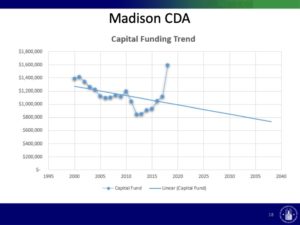 WHICH UNITS ARE THEY TALKING ABOUT?
WHICH UNITS ARE THEY TALKING ABOUT?
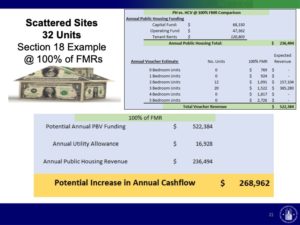 WHAT’S NEXT FOR THE SCATTERED SITE HOUSING UNITS?
WHAT’S NEXT FOR THE SCATTERED SITE HOUSING UNITS?
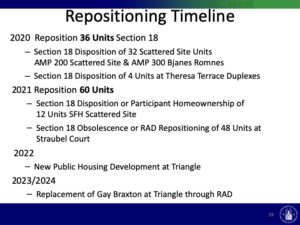 DETAILS OF OTHER UNITS CDA LOOKING AT DISPOSITIONING?
DETAILS OF OTHER UNITS CDA LOOKING AT DISPOSITIONING?
Straubel Court
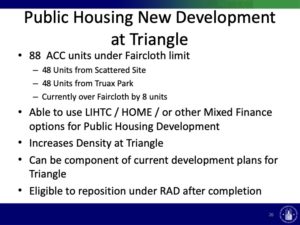 SO, HERE’S MY QUESTIONS
SO, HERE’S MY QUESTIONS
- I should probably know, but where is the huge boost in capital funding coming from in the line graphs above? One of the main reasons for doing this is because there has not been money for capital investments, but it appears that CDA has somehow bucked that trend and has money for capital investments.
- The second reason for doing this is to stabilize funding coming in – but its only a 20 year contract with Section 8 – what happens at the end of 20 years? What guarantees do we have that everything won’t be radically destabilized at that point?
- If the CDA is selling the the units at fair market value to the Madison Revitalization and Community Development Corporation – how does that transaction work?
- Which of the 48 units are being sold – the resolution says 32 units are being sold.
- What communication has been done with the tenants so they know what is going on?
- What rights do the tenants lose in this conversion?

